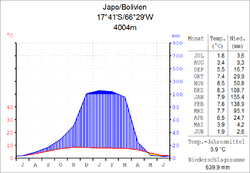Japo Kasa
| Japo Kasa | ||
|---|---|---|
| Basic data | ||
| Residents (state) | 389 pop. (2012 census) | |
| height | 4333 m | |
| Post Code | 03-1101-0305-0001 | |
| Telephone code | (+591) | |
| Coordinates | 17 ° 41 ′ S , 66 ° 44 ′ W | |
|
|
||
| politics | ||
| Department | Cochabamba | |
| province | Tapacarí province | |
| climate | ||
 Climate diagram Japo |
||
Japo Kasa (also just: Japo ) is a town in the Cochabamba department in the South American Andean state of Bolivia .
Location in the vicinity
Japo Kasa is a village in the canton of Challa in the district ( Bolivian : Municipio ) Tapacarí in the province of Tapacarí . It is located at an altitude of 4,333 m on a ridge east of the Río Mujlli , a tributary to the Río Tacopaya , one of the headwaters of the Bolivian Río Grande . The Río Tallija has its source near Japo , which flows northwards from here and becomes the Río Cotacajes via the Río Leque , the Río Ayopaya and the Río Sacambaya , which joins the Río Santa Elena to the Río Alto Beni .
geography
Japo Kasa is located west of the Bolivian Altiplano in the eastern foothills of the Serranía de Sicasica . The climate is a typical time of day climate in which the daily temperature fluctuations are higher than the seasonal fluctuations.
The mean average temperature of the region is around 6 ° C (see Japo climate diagram) and fluctuates only slightly between 2 ° C in June and July and a good 8 ° C in November and December. The annual precipitation is around 650 mm, with a pronounced dry season from May to August with monthly precipitation below 10 mm, and a humidity period from December to February with up to 155 mm monthly precipitation.
Transport network
Japo Kasa is located 119 kilometers by road southwest of Cochabamba , the capital of the department.
From Cochabamba, the paved road Ruta 4 leads in a westerly direction via the cities of Quillacollo and Parotani into the barren mountains of the Serranía de Sicasica and on via Challa Grande to Japo . West of Japo, the road continues to Lequepalca and Caracollo , where it meets Ruta 1 , which crosses the Altiplano from north to south and provides connections to La Paz , Oruro and Potosí .
population
The population of the village has decreased by about a fifth in the past two years:
| year | Residents | source |
|---|---|---|
| 1992 | 496 | census |
| 2001 | 431 | census |
| 2010 | 389 | census |
Due to the historical population distribution, the region has a high proportion of Quechua population, in the municipality of Tapacarí 75.5 percent of the population speak the Quechua language.
Individual evidence
- ↑ INE - Instituto Nacional de Estadística Bolivia 1992 ( Memento of the original from April 23, 2014 in the Internet Archive ) Info: The archive link was inserted automatically and has not yet been checked. Please check the original and archive link according to the instructions and then remove this notice.
- ↑ INE - Instituto Nacional de Estadística Bolivia 2001 ( Memento of the original from May 31, 2014 on WebCite ) Info: The archive link was automatically inserted and not yet checked. Please check the original and archive link according to the instructions and then remove this notice.
- ↑ INE - Instituto Nacional de Estadística Bolivia 2012 ( Memento of the original from July 22, 2011 in the Internet Archive ) Info: The archive link has been inserted automatically and has not yet been checked. Please check the original and archive link according to the instructions and then remove this notice.
- ↑ INE social data 2001 ( Memento of the original from November 13, 2010 in the Internet Archive ) Info: The archive link was inserted automatically and has not yet been checked. Please check the original and archive link according to the instructions and then remove this notice. (PDF file; 7.58 MB)
Web links
- Cochabamba region - Relief map 1: 250,000 (PDF; 10.61 MB)
- Bolívar region - topographic map 1: 100,000 (PDF; 10.78 MB)
- Municipio Tapacarí - General Maps No. 31101
- Municipio Tapacarí - detailed map and population data (PDF; 695 kB)
- Departamento Cochabamba - Social data of the municipalities ( Spanish ) (PDF; 7.58 MB)
